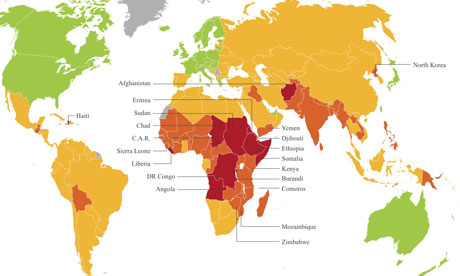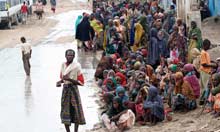Food is the ultimate security need, new map shows
It is a graphic demonstration of the sickening, symbiotic relationship between hunger and conflict and highlights food supply problems from Somalia to India to Spain


Sub-saharan Africa dominates a new food security risk map, while the Indian sub-continent and Iberian peninsula also stand out Map: Maplecroft
A new map of food security risk around the world is, in some ways, depressingly familiar. Sub-saharan Africa leaps out as the place where the most people fear for their next meal, while the rich world has more to fear from obesity. But there's plenty of salutary reminders and fascinating detail, like India's food problems and the vulnerability of Spain.
And it demonstrates the sickening, symbiotic relationship between lack of food and conflict: where one leads, the other follows.
We must start with the worst, in the horn of Africa. In Somalia, Ethiopia and Eritrea, human failings mean a severe drought has tipped millions into famine. It's a textbook case of why things go wrong. War begets poverty, leaving food unaffordable. Devastated infrastructure destroys both food production and the ability to truck in emergency food. The collapse of society means the effects of extreme weather such as drought cannot be dealt with. And the fear of violence turns people into refugees, leaving their livelihoods and social networks behind.
 Refugees wait for food aid in Somalia's capital Mogadishu on August 18, 2011. Photograph: Ismail Taxta/Reuters
Refugees wait for food aid in Somalia's capital Mogadishu on August 18, 2011. Photograph: Ismail Taxta/Reuters The recent spike in food prices, linked by some to the uprisings across north Africa and the Middle East, had also hit hard in Somalia. Maize prices in Mogadishu were 100% higher in June 2011 than in June 2010, and the price of sorghum in Somalia rose by 180% compared with 2010 prices.
Sharing Somalia's unhappy ranking as having the greatest risk of food crisis is the Democratic Republic of Congo, where all the factors above apply, plus the impact of as much as half its rich arable land being land grabbed by foreigners. The situation in DRC is simply scary: it is on track to be one of the most populous nations on Earth in coming years.
Turning to India, the new map, produced by risk analysts Maplecroft, reminds us that behind the booming economy of that vast nation, hundreds of millions of poor people remain hungry. Almost half of India's children are malnourished and one in four of the world's hungry poor live there.
"Despite the enormous economic growth India has and is experiencing, it still has very stark income inequality, which is reflected in the malnourishment and infant mortality data," says Helen Hodge, head of maps and indices at Maplecroft. The Maplecroft index, reviewed last year by the World Food Programme, uses 12 types of data to derive a measure of food risk that is based on the UN FAO's concept. That covers the availability, access and stability of food supplies, as well as the nutritional and health status of populations.
Spain and Portugal stand out as very rare examples of rich nations with a medium risk of food security problems. Hodge explains, that while water problems are an issue there, the major reason is heavy reliance on grain imports. Spain buys in 11bn kilograms of grain more than it exports every year at a cost of $2.6bn, while Portugal pays $890m for 3.3bn kilograms.
"Spain and Portugal have made the decision that olive oil and wine exports are more profitable than grain," she says, along with salad crops. So they sell lettuce and Rioja and buy wheat and corn with the profits.
That calculation may change if global food prices continue on their current upwards trend. In other parts of the world, soaring food costs may well ignite further conflict. "It is striking is how much food security plays into the wider picture of unrest," says Hodge.Source: http://www.guardian.co.uk/environment/damian-carrington-blog/2011/aug/31/food-security-prices-conflict

No comments:
Post a Comment